Sometimes you have to challenge yourself personally. In July 2018, I ran, over a weekend, 42km of trail, faced 90 obstacles and won big medals: it took 9 hours of effort, and I lost sports pants, 2 fingernails of feet, lots of energy and a week afterwards (to recover). In short, I took part in a “trifecta weekend”, a sporting event organized by Spartan where we run the 3 formats of Spartan Races (Sprint, Super and Beast) in 48 hours. This article has absolutely no vocation to give advice, I just tell my story.
For advice on how to prepare for your first Spartan Race, it’s here!
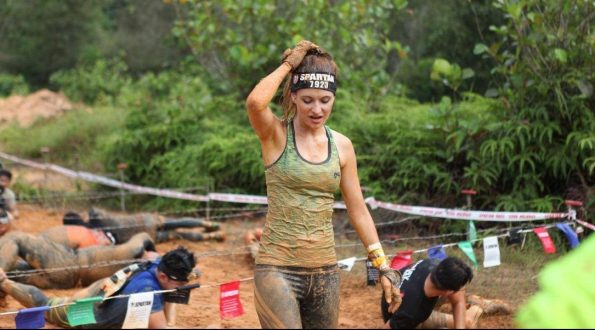
1. The decision
I ran my first Spartan Race in 2017 – a Sprint, with no gear and no preparation, and while the experience was fantastic, I promised myself that I would never do it again. I thought I wasn’t meant for this, because I hated running, and I didn’t have any strength in my arms. And then I continued to register, in increasingly long formats. As a reminder, the Sprint is between 5 and 8km, the Super between 13 and 15, and the Beast, between 21 and 23km.
At the end of 2017, I won my first Trifecta (all 3 formats in the same year) and was ready to take it up a notch. I raced several Spartans in Australia (Melbourne Super / Sprint & Brisbane Bast) in early 2018, and entered age group competition with a Sprint in Singapore. I fell in love with the discipline, and largely adapted my training to make me a much stronger upper body, and work on endurance in the race.
I learned the organization of a trifecta weekend in Malaysia (in Putrajaya, to be precise) in May, and the races were to take place at the end of July. It was enough time to get started, (about 3 months of preparation possible), it was a very nice challenge (21 + 14 + 7km in 2 days, with 90 obstacles to overcome in total ) in the jungle, and I wanted to prove to myself that I was capable of doing something a little crazy that I could be proud of. It was a kind of revenge on the lazy I was before , I think.
In short, the decision was made, I bought the 3-race pass, and it took s ‘put it there for real.
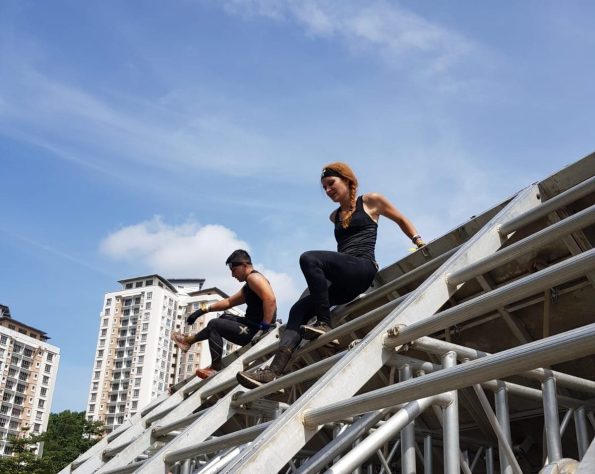
2. Preparation
When preparing for this kind of event, you have to be rational and honest with yourself: you analyze your weaknesses & strengths, and you work on what can be improved.
I had 3 major weaknesses: my endurance was more than average (I was asthmatic on exertion when I was younger, I always hated running, not to mention running 42km of course), I had an upper body always quite weak and, if I am 100% honest, I had an enormous mental weakness during the races: I was quickly discouraged, and one of the races ended in a gigantic anxiety attack on the course (a very bad memory), I was afraid that the mind would let go once more, and prevent me from running the 3 races.
The plan of attack:
1. work on endurance
Because I still hate running, I forced myself to include a minimum of 30min of interval running at the start of 3 sessions per week (and work on my upper body afterwards.) alternated walking (6.5kmh) / slow running (10kmh) / sustained running (12.5kmh), changing pace every minute.
2. Strengthening the upper body
I dropped the machines for 3 months, to concentrate on a much more functional training: Crossfit movements (with free weights) and calisthenics (at the weight of the body), lots of pull-ups .. Enough to give me a back and shoulders capable of carrying me in all circumstances.
It also implied that I agree to “take arms” – something that I refused since years, for the purely visual side. But in the end, I’m very happy with the look too: I have stronger arms, a more defined back and I stand much better (in addition to being able to lift my own weight without any problem!)
3. Work the mind
I spoke a lot with competitive athletes, who gave me great advice. Visualize the race before setting off, visualize each obstacle (imagining passing it) before crossing it, making lists (of anything) during the passages of the race so as not to find the time long or think about the heat. You should not let yourself be defeated even when you fail or when you feel fatigue and pain. We keep going, and each step brings us closer to the finish line (and of course, the faster we get there … the faster it’s over.)
To be honest, I trained hard, but not as hard as I would have liked, for various reasons (a 2 week stay in France & Dubai, a few “party” weekends in Asia without a gym available, a little tired knee at times). I slowed down heavily on the alcohol the month before the race, and strained the carbs the week before, just to build up some worthy glycogen stores.
3. Race day (s)
We arrived on site the day before the first races. For 2 days, meals consisted mostly of complex carbohydrates and protein – not enough fat to avoid digestion concerns. (but that’s a personal preference).
Since we didn’t do anything else over the weekend, here’s our program (with nutritional details, if some are interested!)
Race day before (Friday)
Evening : wholemeal pasta + chicken breast + Roasted vegetables with a dash of olive oil
Race Day 1 (Saturday)
Breakfast : oat pancake + Roast beef + banana
Spartan Beast (2 cereal bars during the race)
After the race : 1 high protein bar
Afternoon: Brunch (cracking but healthy, toast salmon and eggs, spider crab burger .. a marvel!) + a 1 hour massage ( which did a lot of good to muscle aches)
Evening ( the day before race 2 ): wholemeal pasta + tuna in water + tomato sauce without MG + pear
Race Day 2 (Sunday)
Breakfast : 2 eggs + wholemeal bread + 1 banana
Spartan Super (1 cereal bar during the race) Between races : 1 energy bar + 1 banana
Spartan Sprint (1 bar during the race)
Post course : 1 high protein bar
Afternoon / Evening : Crack at Nando’s
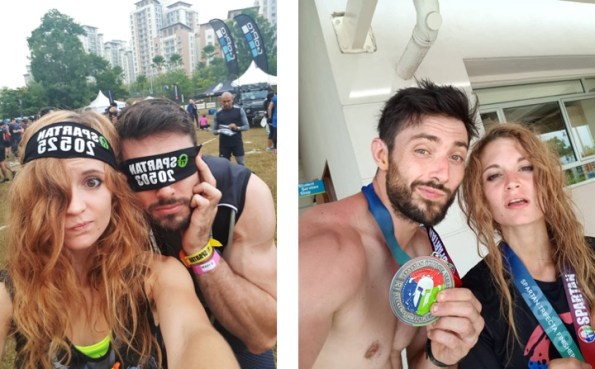
4. Results & feedback
Beast (21km, 33 obstacles): I ran it with my boyfriend, in the Open. It took us 4:20 to get through it, and I needed a little help from him on 2 or 3 sheer showdowns. We knew we had to run again the next day, so we didn’t rush, and we spent some time together, rather than trying to do a perf.
Super (14km, 28 obstacles): Not really motivated before leaving, I was very surprised to have so much fun on the course. After the 1st mile, my body had warmed up and my body aches were gone, and I “wanted” to have a fair time. I had fun, I ran without really thinking about it, and morale was high. I was sure I was in the top 10% crossing the finish line: I finished first in my category (Open, Female, Age-group) and third in women. Really happy.
I ran it alone, because my partner in crime had chosen to run it in Elite – but I met some very nice people on the race, and the atmosphere helped me a lot to keep up. at the end.
Sprint (8km, 22 obstacles): Unsurprisingly, no way to get a good time, I discovered that my body had fairly strict limits and that exceeding them was impossible. On the Sprint course (with a lot of people on the obstacles), impossible to move forward. Sunstroke and a great pain in the lower body slowed down every movement, and completing the 8km loop was a real challenge.
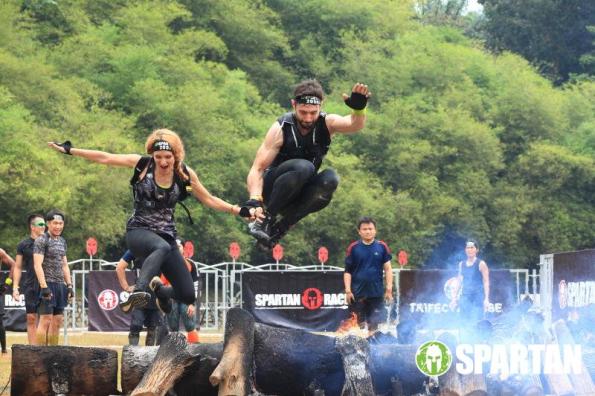
5. After the race (and the aches!)
We’re not going to lie to each other, I didn’t expect to suffer so much during the last race. The hours that followed were very painful (mainly because of the sunstroke), and we had to queue in the full sun to collect the medals, then shower at the Karcher in the festival area (for lack of a hotel room within reach) before leaving for the airport and returning to Singapore.
The first real shower was an opportunity to take stock : bruises everywhere, more or less deep cuts, two infected toenails (which I then lost, good ap!), pain in the knees, in the shoulders, and the legs infinitely heavy . But the worst was the fatigue : the 2 days that followed, I was both physically tired (with stiffness especially on the front of the legs, because of the mountainous route and the descents in the pebbles) and mentally exhausted: I had used all my ability to concentrate, and I was in a kind of constant fog. I slept badly, because I dreamed of running, and my damaged feet were tapping against roots or obstacles, and the pain woke me up.
Anyway, the aftermath was an ordeal in itself , and I’m glad to have recovered since.
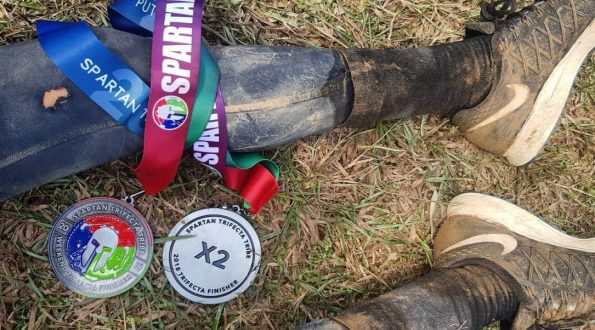
And in the end?
I am really, REALLY glad I did. It was the challenge I needed to prove to myself that I was worth something in sport, that I had the n yeah it took, that I was able to put aside the pain and the frustration to reach my goals.
If I had to change something .. I would practice even more (not in quantity, but in quality, there have been days I know I haven’t pushed enough) and I would doubt myself less.
Will I do it again? Probably not: it was very hard for the body to take, and I kind of “ticked the box”; I will now train to perform really better on the short formats (Sprint but especially Super) and will continue to run the Beasts for fun.
